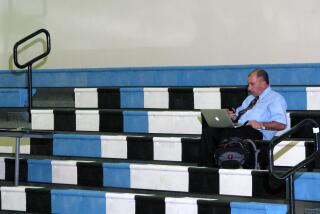A Small College With a Mean Streak
McMINNVILLE, Ore. — You wonder what else can go right for Oregon.
Last weekend, the state conked USC and crowned a new Miss America on the same night.
Last year, Oregon State made Notre Dame look like an intramural squad in the Fiesta Bowl and this week awaits the chance to do the same to UCLA when the Bruins visit Corvallis.
We’re green with envy. But wait, there’s more.
Oregon is also caretaker of one of the more remarkable, yet little-known, feats in sports.
Folks at tiny Linfield College referred to it simply as “The Streak,” and while most concede it can’t last forever, no one is ready to surrender it on their watch.
“Not while I’m here,” running back David Russell says. “The streak is not going to end.”
Linfield football has not posted a losing season since 1955, a stretch that spans 10 U.S. presidents and several moon walks. A private Division III school located about an hour’s drive southwest of Portland, Linfield last year extended its NCAA-record streak of consecutive winning seasons to 45, although the Wildcats are, gulp, 1-1 entering this weekend’s game against Pacific Lutheran.
In 1998, Linfield established the NCAA record with its 43rd winning season in a row, eclipsing the mark of 42, previously shared by Harvard and Notre Dame.
At 39 and counting, Nebraska holds the longest current streak of winning seasons among Division I schools.
“Yeah,” Russell says, “but we’ve got 45. But it’s not about publicity. We’re Division III, we’re not too concerned about the public eye.”
Football jewels can be unearthed in the most unlikely hamlets. Two years ago, Division III Mount Union of Ohio broke Oklahoma’s hallowed mark of 47 consecutive victories, yet what Linfield has done may be more impressive.
The streak means everything to Linfield players and fans. It is considered a sacred trust, passed down from class to class.
And were it to end?
“All those people who were here before, you’d let them down,” defensive end Chad Barrett says.
There probably would be no streak talk if not for Dennis Anderson, a sportswriter for the Honolulu Advertiser who played on the 1954 Linfield team that finished 3-6.
When Anderson’s son, Bryant, chose to attend Linfield in the 1980s, Dennis became enamored of the program, then coached by the legendary Ad Rutschman.
“When you watched Rutschman conduct practice, there’d be guys all over the field,” Anderson says. “He’d say one word and they’d be running full tilt. He didn’t have to blow a whistle. He had a command about him.”
Anderson was so impressed he begin using his vacation and comp time to spend football seasons at Linfield to help out as an administrative aide.
Anderson has spent 14 of his last 16 falls in McMinnville.
In 1986, while working on another project, Anderson independently started compiling information on consecutive winning seasons. He says the NCAA didn’t keep such information. Anderson established the record was shared by Notre Dame and Harvard at 42 and that Linfield was creeping up the list.
The streak took on a life of its own, culminating with Linfield’s 20-19 victory over Willamette on Oct. 17, 1998, which secured the school’s 43rd consecutive winning season.
Fans tore down the goal posts.
Linfield has added two more winning seasons since, and its cumulative record since 1956 stands at 338-88-10.
Yet, some players think obsession with the streak can be a burden because it lowers expectations, since it only takes a 5-4 season to maintain the record. It’s rumored the school does not schedule 10 games because that would require six wins to preserve the record.
“We don’t talk about it,” Barrett says of the streak. “We expect to at least not have a losing season. That’s the minimum.”
Close calls? You bet.
The 1987 team started 1-4. Joe Brimm, an offensive lineman, started the chant “33!!!” as a rallying cry.
Actually, the streak at the time was only 31 seasons, but it was the thought that counted.
“He got the math wrong,” Linfield Coach Jay Locey, the defensive coordinator on the 1987 team, says.
Late that season, a Linfield player batted down a fourth-down pass against Lewis and Clark to preserve a victory and go to 3-4, then the team won its last two games to finish 5-4.
In 1996, Locey’s first season as coach, Linfield had to win its last two games to finish 5-4.
“That might have been my first and last year,” Locey jokes.
There is no easy explanation as to how Linfield has maintained the streak for more than four decades.
“You have to be lucky a bit, to keep something like that alive,” basketball Coach Larry Doty, who played receiver at Linfield in the 1970s, says.
Continuity has been a key. Linfield has had only four football coaches since 1948: Paul Durham, Rutschman, Ed Langsdorf and Locey.
Rutschman is considered the spiritual backbone of the program, leading the Wildcats to three National Assn. of Intercollegiate Athletics national titles and 24 consecutive winning seasons before he retired in 1992.
Linfield moved to Division III in 1998.
Rutschman, a Linfield graduate, set the standard for excellence. He is known as “The Lombardi of Linfield,” a man who devoted his life to the school. Many say Rutschman could have been a top coach at any level, including the NFL, but chose to work his magic in a small circle.
“That doesn’t make him any less of a coach,” Doty says. “In some regards, it makes him more of a coach.”
Rutschman was recently inducted into the College Football Hall of Fame and he says 120 of his former players went on to become head coaches.
Mike Riley, the San Diego Chargers’ coach and a one-time Linfield assistant, is Rutschman’s most accomplished offspring.
Asked why he stayed, Rutschman says, “I’ve never been a person who has looked ahead. I’ve had only two jobs in my life, and I didn’t apply for either one.”
On a much smaller scale, he likens the program’s template to Nebraska’s, which moved seamlessly from coaches Bob Devaney, Tom Osborne and Frank Solich en route to 39 consecutive winning seasons.
Rutschman was a straight arrow. He did not allow cursing or his players wearing caps in public places. The team motto, etched above the locker-room entrance at Maxwell Field, is: Are You a Better Football Player Today Than You Were Yesterday?
As for the streak, Rutschman offers: “If you absolutely had to come up with a reason why, you could sum it in one word: performance.”
Rutschman was a great tactician and disciplinarian, but he also developed important out-of-state recruiting pipelines. While playing NAIA, Linfield was allowed to offer scholarships.
Not so now. Rutschman was opposed to the school’s decision to join the Northwest Conference in joining NCAA Division III. Some think not being allowed to offer scholarships puts the streak at risk.
Folks will get antsy if Linfield falls to 1-2 with a loss against rival Pacific Lutheran this week.
“Man, I don’t want to be part of the team that ruins the streak,” running back Russell says. “You’d have to leave the state ... seriously.”
Hurry-Up Offense
Coach in crisis, Part I: Bob Davie, Notre Dame: The university’s patience will be tested if the Irish fall to 0-3 for the first time in school history with a loss at Texas A&M.; “I didn’t know we were 0-3 yet,” Davie snapped this week. Notre Dame’s problem is more than a plodding offense that has scored two touchdowns in two games, both of which were set up by special teams. Notre Dame’s problem is that it recently rewarded Davie with a five-year contract extension that pays him $1 million a year through 2005. Alabama has no problem passing the hat to buy out a coach’s contract, but Notre Dame is supposed to serve a higher purpose. Gripes, it let Gerry Faust hang around five years. But make no mistake: A defeat at Texas A&M; will set off cries for Davie’s ouster and make men in collars squirm.
Coach in crisis, Part II: Joe Paterno, Penn State. We never thought we’d live to see it, but a Pittsburgh Post-Gazette columnist this week called for Paterno to retire at the end of the season. Penn State is 0-2, has lost 12 of its last 18 games and Paterno still needs two victories to pass Bear Bryant on the major college all-time victory list. Penn State faces the distinct possibility of losing at much-improved Iowa this week and then faces a Big Ten gantlet of Michigan, Northwestern and Ohio State.
The Nittany Lions at 0-6? It could happen. Paterno, though, shows no signs of concession. “When I accept a loss, then you guys can write stories about my retirement,” he said at his press conference this week. “I am excited about the challenge. I am angry.”
Coach in crisis, Part III: Bobby Bowden, Florida State. OK, the word crisis is relative here, but the Seminoles’ drop to No. 18 in the polls this week after a 41-9 loss to North Carolina indicates a clear lack of consumer confidence. Bowden’s teams have bounced back from losses before. In fact, Bowden has posted only one perfect season in his remarkable career, the 12-0 run to the 1999 national title. Florida State rebounded from a defeat against Notre Dame in 1993 to win the national title, and earned a place in the 1998 title game after an early season loss to North Carolina State. “Will we respond from an ugly defeat? That’s what it’s down to,” Bowden said. The problem is this season’s team, already young, has suffered nine injuries and is woefully inexperienced at quarterback. Florida State still has to play Miami, Florida and Georgia Tech. Barring a quick recovery, this could be the Seminoles’ first three-loss season since they went 7-4-1 in 1986.
Rutgers has been outscored, 111-0, in its last two Big East Conference losses to Miami and Virginia Tech, the most the Scarlet Knights have been outscored in any two-game stretch in the school’s 113-year history.
More to Read
Go beyond the scoreboard
Get the latest on L.A.'s teams in the daily Sports Report newsletter.
You may occasionally receive promotional content from the Los Angeles Times.











